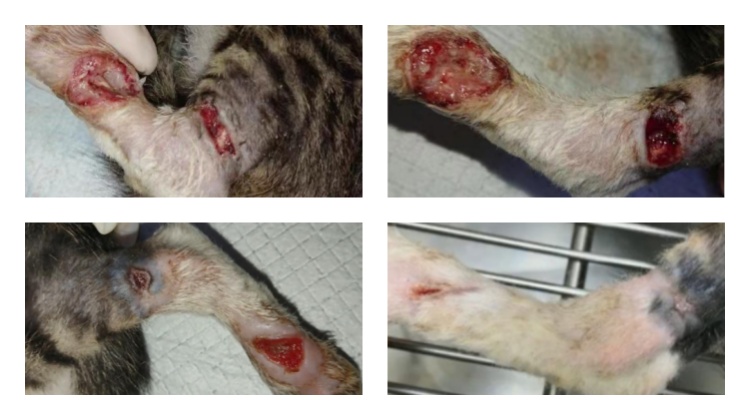
2023-06-20 1552
1.Case presentation:
NAME: Simpli
SPECIES: Canine
GENDER: Male
AGE: 1
WEIGHT: 6.3kg
The right hind limb of the affected cat was clamped by mice, contusion, wound penetration, wound infection and purulent. Other circumstances are unknown
2.Examination
Body temperature 38.2 C, breathing 48 breaths / min, heart rate 180 beats / min, normal pupils, conscious and alert, and BCS 5 / 9. The right hind limb did not touch the ground, and there was sensitive pain on palpation. Besides, there were no other obvious abnormalities on physical examination.
3.Diagnosis
Hdlimb lameness caused by traumatic infection of the right hind limb
4.Treatment
4.1Treatment plan
Fully flush the wound with mild, sterile normal saline and hydrogen peroxide, and trim off the necrotic and rotten tissue with tweezers and scissors. After the washing was completed, the laser treatment was used. Due to the penetration of the wound, laser treatment was conducted on the inner and outer sides of the affected limb. After the laser, Bailing gold square cream was applied to the wound and bandaged up.
4.2Laser therapy
Preset-cat-acute wound mode-time 25%up Power 50%up, 25mm treatment head,by LUNVET 4 wavelength laser.
Total number of laser treatments: 8 (once a day for the first 5 days and once the next day)
4.3Treatment process
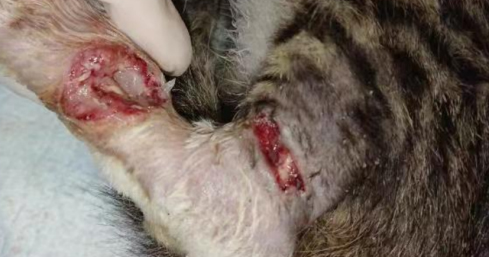 |
7.16 Before laser therapy |
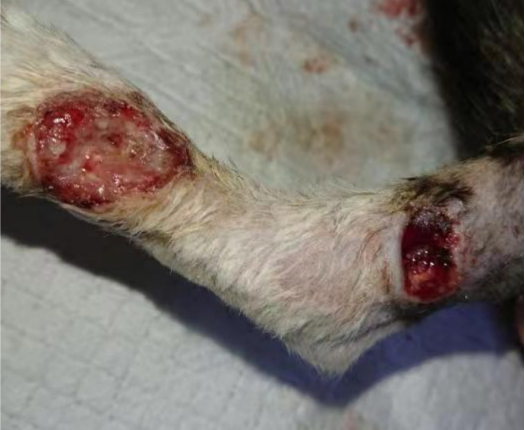 |
7.19 After two laser treatments, there was no rotten tissue in the proximal tarsal wound, and the rotten tissue was still found deep in the metatarsal joint, and the edge of the wound was obvious |
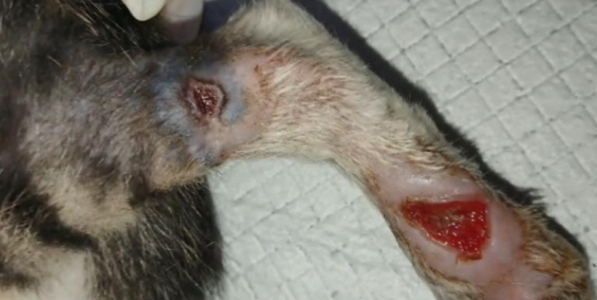 |
7.25 After 7 times of laser treatment, the metatarsophalangeal joint wound is significantly reduced, the edge scab is obvious, and nearly healed. The wound of the dorsal side of the metacarpal was narrowed, and no obvious rotten and necrotic tissue or purulent exudate was found. |
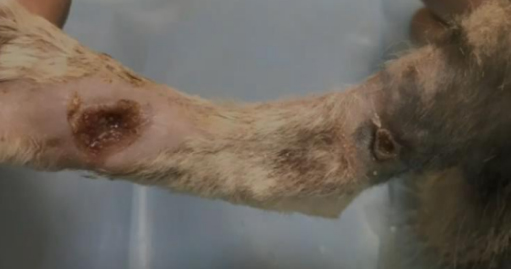 |
7.26 After eight laser treatmentst, the wound at the metatarangeal joint healed well and the wound at the dorsal side of the metacarpal was nearly completely healed |
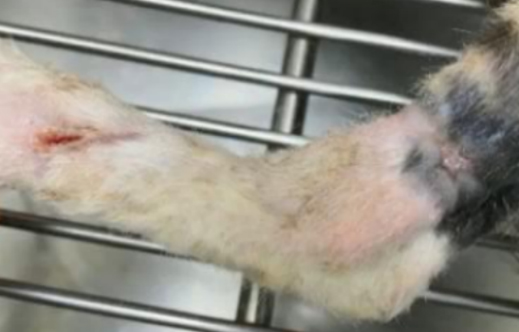 |
After the cessation of laser treatment, the wound at the metatarangeal joint healed well and the wound at the dorsal side of the metacarpal was nearly completely healed |
5.Summary
Compared with before treatment, the wound was significantly reduced, healed rapidly, the pain sensitivity was reduced, the affected limb returned to normal, and no obvious abnormality in gait appeared.
In this case, after laser treatment, the wound exudation decreased, the pain degree was reduced, the lesion area decreased significantly, and the recovery speed was very fast. Without laser therapy, the recovery time may take more than three weeks or even more, only through conventional debridement and the application of antibiotics.
When the animals received laser physiotherapy, they performed very well and showed no resistance to laser irradiation. This makes the whole treatment process go very smoothly.Relative to the traditional treatment of acute trauma infection, laser is a new type, non-drug physical therapy, has the side effects of drugs, convenient use, short treatment cycle, at the same time laser stimulation of animal wounds, animals generally accepted good, compared with the traditional treatment method, can reduce the stress response of animal treatment, can greatly improve the animal welfare of sick animals.
6. Discuss
Trauma (trauma) is the destruction of body tissues or organs.[] When severe trauma can cause systemic reaction, local manifestations of pain, swelling, tenderness in the injury area; deformity and dysfunction in fracture dislocation. In the initial 3 - 5 days is the stagnation period of wound healing, dominated by inflammation and debridement.
Muscle damage, where external shocks disrupt the continuity of muscle fibers and tear the blood vessels, causes considerable pain during exercise. If the damaged muscles are not properly handled in time, the healing process is delayed, and fibrosis will occur at the muscle broken end in the future. Excessive scarring may affect the muscle regeneration and interfere with the normal physiological function of the muscles.
A number of animal trials and clinical treatments have shown that laser can affect growth factor release, blood vessel formation and relieve inflammation, while increasing the release of endorphins to relieve pain.Therefore, in addition to the removal of wound necrosis and thorough washing of trauma, laser treatment was applied.The classic manifestations of inflammation are "redness, swelling, heat and pain" and dysfunction. After three laser treatment in this case, the redness and swelling of the lesion obviously subsided, and the pain degree was reduced, thus reflecting the anti-inflammatory and analgesic effects of laser.After a week of treatment, the edge of the lesion scab, and the animal gait tended to be normal, indicating that in addition to the obvious anti-inflammatory effect, laser can also promote tissue repair and healing, accelerate the recovery of the body. It can be seen that laser treatment has a positive effect on pain management, inflammation and healing in the affected animals.
In general, laser, as an auxiliary therapeutic means, convenient to use and wide application, is a worthy technology for clinical application in animals.